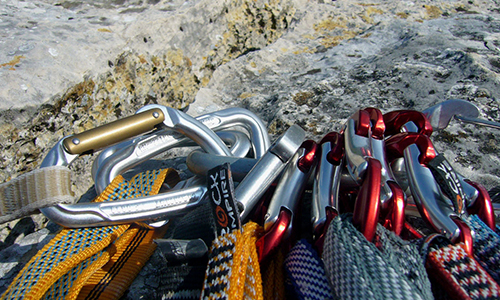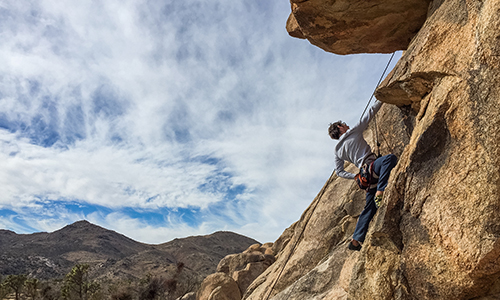Why Retiring Your Climbing Gear Is Necessary and When Should You Do It
Author

Chris shares his passion for cycling, hiking, skiing, and climbing from Buxton, in the Peak District. As a blogger for Outdoor Look, Chris shares outdoor tips and indoor tricks to help you get the most out of your time spent outside. When he's not out adventuring he's making videos or trying to keep up with his 4-year-old son.
 It is essential that you recognise the time when your equipment needs to be changed. Identifying the visible damages and keeping in consideration the manufacturing date, you should make the call. Sometimes, though, it gets difficult to gauge whether the equipment is still capable of being used extensively. In this scenario, you can ask around on the internet or go to a climbing equipment store.
It is essential that you recognise the time when your equipment needs to be changed. Identifying the visible damages and keeping in consideration the manufacturing date, you should make the call. Sometimes, though, it gets difficult to gauge whether the equipment is still capable of being used extensively. In this scenario, you can ask around on the internet or go to a climbing equipment store.
Here are some equipment specific details on when the equipment should be retired:
Climbing Rope – The rope should be retired if you have encountered fall with heavy load or have caused some damage to the structure of the rope. Frequent users should retire the rope in a year or sooner. A regularly used climbing rope should be retired in 1-3 years. For occasional users the retirement time ranges from 4-5 years. A rarely used rope can go up to 7 years before it is retired. The life of a climbing rope is 10 years if not used at all. Also, if you have been in a fall with heavy load, you must immediately change the rope and make sure that no one uses the retired one.
Climbing Harness – Look for fraying or rips in the webbing of the harness. If there is excessive abrasion to the bar-tacks, then it is time for you to retire the harness. Damaged buckles and discolored webbing are also an indication for you to change the harness. Some harnesses have a wear indicator in the belay loop. If the indicator is visible, then it is time to throw away the harness.
Carabineers – If you find any missing, bent or loose rivets on the carabineer, throw it away. A carabineer with deep grooves caused by ropes is not safe to use and should be retired. Metal burrs, faulty locking mechanism, sharp edges, corrosion or any cracks are an indication that the carabineer is not fit to use and must be replaced.
Climbing Helmet – Check if there is any major damage like a dent or crack on the outer shell of the helmet. This is not good, especially when you are regularly using the helmet. Look for damaged foam inside the helmet or damaged buckle or other hardware. Check if the webbing is torn or fraying. If any of these conditions are there on your helmet, then you should look forward to buy a new one.
 Webbing, Cords and Climbing Slings – Just like any other gear mentioned before, the life span of webbing, cords and climbing slings depends upon the frequency of their use. Webbing, cords and climbing slings, if ripped, burnt or singed, must be retired. If the gear is fraying or has any loose stitching, it should be retired. Discoloration, fading or melted areas are not good for the safety of the gear.
Webbing, Cords and Climbing Slings – Just like any other gear mentioned before, the life span of webbing, cords and climbing slings depends upon the frequency of their use. Webbing, cords and climbing slings, if ripped, burnt or singed, must be retired. If the gear is fraying or has any loose stitching, it should be retired. Discoloration, fading or melted areas are not good for the safety of the gear.
You can also find different uses for all these gears instead of throwing them away in the trash. Some really cool out-of-the-box recycling ideas can be thought of to make a completely different use of the climbing equipment. For example, Carabineers can be used as keychains or keepers for water bottles, the retired rope can be turned into a dog leash or a rug.
Author

Chris shares his passion for cycling, hiking, skiing, and climbing from Buxton, in the Peak District. As a blogger for Outdoor Look, Chris shares outdoor tips and indoor tricks to help you get the most out of your time spent outside. When he's not out adventuring he's making videos or trying to keep up with his 4-year-old son.
- Speed Up Your Post-Hike Recovery with These 6 Essential Tips
- Cycling through Tranquil Roads and Coastal Views on the Isle of Wight
- The Essential Guide to Hiking Safety: 5 Tips Every Hiker Should Know
- Run Smart, Run Strong: Your Guide to Injury-Free Running
- Embrace Biking: Essential Tips for Beginners
Categories
- Sport (28)
- Product Reviews (3)
- Team Outdoor Look (7)
- Mike Wild (2)
- Mike Payton (2)
- Suse Hammond-Pears (3)
- Snowboarding (12)
- Latest Offers (105)
- Shop Talk (1)
- Competitions (7)
- Walking (413)
- Lifestyle Fashion (8)
- Travel (86)
- Kit Guides (176)
- Workwear Clothing (6)
- Safety Workwear (4)
- Health/Fitness (289)
- Skiing (91)
- Great Outdoors (1316)
- Cycling (92)
- January 2025
- December 2024
- November 2024
- October 2024
- September 2024
- August 2024
- July 2024
- June 2024
- May 2024
- April 2024
- March 2024
- February 2024
- January 2024
- December 2023
- November 2023
- October 2023
- September 2023
- August 2023
- July 2023
- June 2023
- May 2023
- April 2023
- March 2023
- February 2023
- January 2023
- December 2022
- November 2022
- October 2022
- September 2022
- August 2022
- July 2022
- June 2022
- May 2022
- April 2022
- March 2022
- February 2022
- January 2022
- December 2021
- November 2021
- October 2021
- September 2021
- August 2021
- July 2021
- June 2021
- May 2021
- April 2021
- March 2021
- February 2021
- January 2021
- December 2020
- November 2020
- October 2020
- September 2020
- August 2020
- July 2020
- June 2020
- May 2020
- April 2020
- March 2020
- February 2020
- January 2020
- December 2019
- November 2019
- October 2019
- September 2019
- August 2019
- July 2019
- June 2019
- May 2019
- April 2019
- March 2019
- February 2019
- January 2019
- December 2018
- November 2018
- October 2018
- September 2018
- August 2018
- July 2018
- June 2018
- May 2018
- April 2018
- March 2018
- February 2018
- January 2018
- December 2017
- November 2017
- October 2017
- September 2017
- August 2017
- July 2017
- June 2017
- May 2017
- April 2017
- March 2017
- February 2017
- January 2017
- December 2016
- November 2016
- October 2016
- September 2016
- August 2016
- July 2016
- June 2016
- May 2016
- April 2016
- March 2016
- February 2016
- January 2016
- December 2015
- November 2015
- October 2015
- September 2015
- August 2015
- July 2015
- June 2015
- May 2015
- April 2015
- March 2015
- February 2015
- January 2015
- December 2014
- November 2014
- October 2014
- September 2014
- August 2014
- July 2014
- June 2014
- May 2014
- April 2014
- March 2014
- February 2014
- January 2014
- December 2013
- November 2013
- October 2013
- September 2013
- August 2013
- July 2013
- June 2013
- May 2013
- April 2013
- March 2013
- February 2013
- January 2013
- December 2012
- November 2012
- October 2012
- September 2012
- August 2012
- July 2012
- June 2012
- May 2012
- April 2012
- March 2012
- February 2012
- January 2012
- December 2011
- November 2011
- October 2011
- September 2011
- August 2011
- May 2010
- April 2010
- March 2010
- February 2010
- January 2010
- November 2009
- October 2009
- September 2009
Submit a Comment